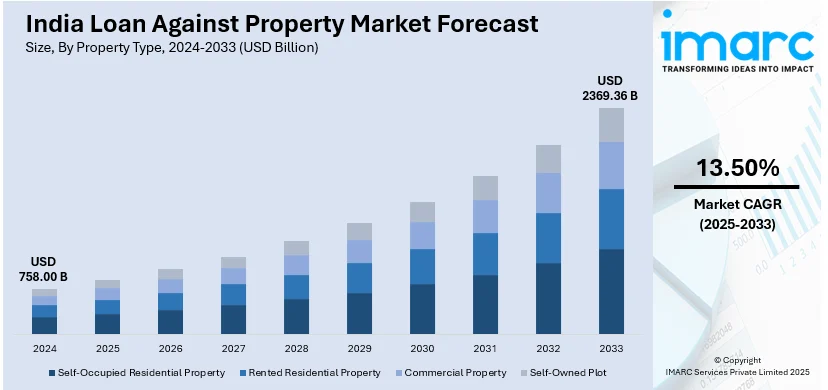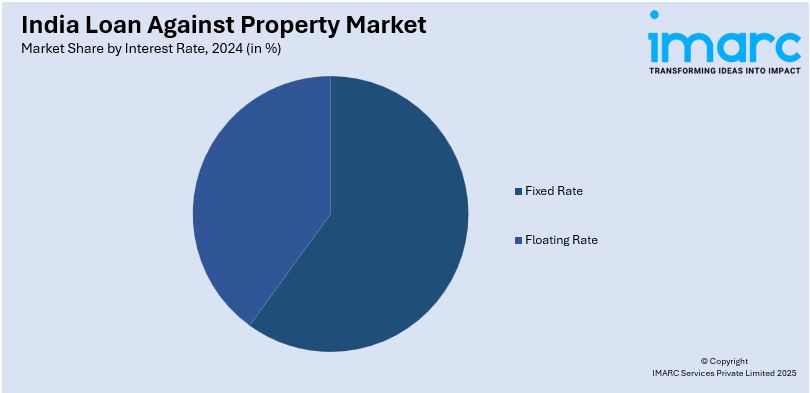
India Loan Against Property Market Size, Share, Trends and Forecast by Property Type, Interest Rate, Tenure, and Region, 2025-2033
India Loan Against Property Market Overview:
The India loan against property market size reached USD 758.00 Billion in 2024. Looking forward, IMARC Group expects the market to reach USD 2,369.36 Billion by 2033, exhibiting a growth rate (CAGR) of 13.50% during 2025-2033. The India loan against property market is expanding due to increasing MSME credit demand in Tier 2-4 cities and financial institutions diversifying into non-housing loans. Rising secured loan adoption, flexible repayment options, and targeted lending initiatives are driving market growth and accessibility.
|
Report Attribute
|
Key Statistics
|
|---|---|
|
Base Year
|
2024 |
|
Forecast Years
|
2025-2033
|
|
Historical Years
|
2019-2024
|
| Market Size in 2024 | USD 758.00 Billion |
| Market Forecast in 2033 | USD 2,369.36 Billion |
| Market Growth Rate (2025-2033) | 13.50% |
India Loan Against Property Market Trends:
Rising MSME Credit Demand in Tier 2-4 Cities
The growing need for credit among Micro, Small, and Medium Enterprises (MSMEs) in Tier 2-4 cities is driving the loan against property market in India. As these regions witness increasing economic activities, small businesses require accessible financing solutions to sustain and expand their operations. Traditional banking channels often have stringent lending requirements, making LAP an attractive alternative due to its secured nature and relatively lower interest rates. This trend is particularly significant in smaller cities where MSMEs face funding gaps and limited access to formal credit. In October 2024, Arka Fincap launched ‘Uday,’ a Small Ticket Loan Against Property (STLAP) scheme, targeting MSMEs with loan amounts ranging from INR 10 Lakh to INR 30 Lakh. Initially rolled out in five cities in Tamil Nadu, this initiative addresses the financial needs of small businesses in Tier 2-4 regions, promoting economic inclusion. With government initiatives supporting MSMEs and financial institutions introducing specialized LAP products, the demand for secured loans in smaller cities is expected to rise. This shift enables business expansion, improves credit accessibility, and fosters regional economic development, positioning LAP as a crucial funding option for small enterprises in emerging markets.

To get more information on this market, Request Sample
Expansion of Non-Housing Loan Portfolios
The diversification of financial institutions into non-housing loan segments is a key driver of the Loan Against Property (LAP) market in India. Lenders are increasingly focusing on secured loans beyond traditional home financing to improve profitability and balance their lending portfolios. The LAP segment, being asset-backed, offers lower risk compared to unsecured loans, making it a preferred choice for lenders aiming to expand their non-housing portfolios. With growing business needs and personal financial requirements, borrowers are seeking flexible LAP options, prompting financial institutions to introduce dedicated loan verticals. PNB Housing Finance announced the launch of a dedicated LAP vertical under its retail segment in April 2025. This initiative aims to increase its non-housing portfolio to 30%, offering higher loan limits and flexible repayment terms. By focusing on LAP, the lender is diversifying its revenue sources while catering to a broader customer base seeking secured credit solutions. As more financial institutions recognize the potential of LAP in strengthening their non-housing loan segments, the market is expected to witness increased product innovation, competitive interest rates, and improved lending accessibility. This shift enhances credit availability for businesses and individuals while supporting financial institutions' long-term growth strategies.
India Loan Against Property Market Segmentation:
IMARC Group provides an analysis of the key trends in each segment of the market, along with forecasts at the region/country level for 2025-2033. Our report has categorized the market based on property type, interest rate, and tenure.
Property Type Insights:
- Self-Occupied Residential Property
- Rented Residential Property
- Commercial Property
- Self-Owned Plot
The report has provided a detailed breakup and analysis of the market based on the property type. This includes self-occupied residential property, rented residential property, commercial property, and self-owned plot.
Interest Rate Insights:

- Fixed Rate
- Floating Rate
The report has provided a detailed breakup and analysis of the market based on the interest rate. This includes fixed rate and floating rate.
Tenure Insights:
- Up to 5 Years
- 6-10 Years
- 11-24 Years
- 25-30 Years
A detailed breakup and analysis of the market based on the tenure have also been provided in the report. This includes up to 5 years, 6-10 years, 11-24 years, and 25-30 years.
Region Insights:
- North India
- South India
- East India
- West India
The report has also provided a comprehensive analysis of all the major regional markets, which include North India, South India, East India, and West India.
Competitive Landscape:
The market research report has also provided a comprehensive analysis of the competitive landscape. Competitive analysis such as market structure, key player positioning, top winning strategies, competitive dashboard, and company evaluation quadrant has been covered in the report. Also, detailed profiles of all major companies have been provided.
India Loan Against Property Market News:
- March 2025: HDFC Bank announced updated Loan Against Property (LAP) interest rates, ranging from 9.50% to 11%, with flexible repayment options and prepayment benefits. This enhances affordability, improves borrower accessibility, and strengthens market competitiveness by offering structured mortgage financing for urgent financial needs.
- December 2024: Bajaj Housing Finance introduced a Dual Rate Loan Against Property, offering a fixed interest rate for the first three years, followed by a floating rate linked to BHFL’s FRR. This development boosts market stability, attracting borrowers seeking predictable EMIs and flexible refinancing options.
India Loan Against Property Market Report Coverage:
| Report Features | Details |
|---|---|
| Base Year of the Analysis | 2024 |
| Historical Period | 2019-2024 |
| Forecast Period | 2025-2033 |
| Units | Billion USD |
| Scope of the Report |
Exploration of Historical Trends and Market Outlook, Industry Catalysts and Challenges, Segment-Wise Historical and Future Market Assessment:
|
| Property Type Covered | Self-Occupied Residential Property, Rented Residential Property, Commercial Property, Self-Owned Plot |
| Interest Rate Covered | Fixed Rate, Floating Rate |
| Tenure Covered | Up to 5 Years, 6-10 Years, 11-24 Years, 25-30 Years |
| Regions Covered | North India, South India, East India, West India |
| Customization Scope | 10% Free Customization |
| Post-Sale Analyst Support | 10-12 Weeks |
| Delivery Format | PDF and Excel through Email (We can also provide the editable version of the report in PPT/Word format on special request) |
Key Benefits for Stakeholders:
- IMARC’s industry report offers a comprehensive quantitative analysis of various market segments, historical and current market trends, market forecasts, and dynamics of the India loan against property market from 2019-2033.
- The research report provides the latest information on the market drivers, challenges, and opportunities in the India loan against property market.
- Porter's five forces analysis assist stakeholders in assessing the impact of new entrants, competitive rivalry, supplier power, buyer power, and the threat of substitution. It helps stakeholders to analyze the level of competition within the India loan against property industry and its attractiveness.
- Competitive landscape allows stakeholders to understand their competitive environment and provides an insight into the current positions of key players in the market.
Key Questions Answered in This Report
The loan against property market in India was valued at USD 758.00 Billion in 2024.
The India loan against property market is projected to exhibit a (CAGR) of 13.50% during 2025-2033, reaching a value of USD 2,369.36 Billion by 2033.
The market is fueled by deepening financial inclusion, appreciation in property values, and the need for cheap credit options. Salaried workers and small enterprises are interested in collateralized working capital or personal loans. Digital lending platforms and simplified approval processes have eased access to the market, while easy repayment terms and reduced interest rates lure borrowers.
Need more help?
- Speak to our experienced analysts for insights on the current market scenarios.
- Include additional segments and countries to customize the report as per your requirement.
- Gain an unparalleled competitive advantage in your domain by understanding how to utilize the report and positively impacting your operations and revenue.
- For further assistance, please connect with our analysts.
 Request Customization
Request Customization
 Speak to an Analyst
Speak to an Analyst
 Request Brochure
Request Brochure
 Inquire Before Buying
Inquire Before Buying




.webp)




.webp)












